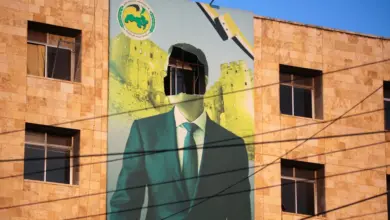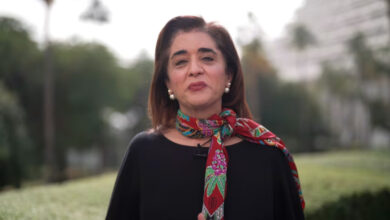
BEIRUT (AP) — Late one night in 2015, a friend of Yasmen Almashan tagged a photo to her Facebook account. The notification ended a tormented wait for a sign from her brother, detained three years earlier by Syrian troops.
The photo of Okba, Almashan’s older brother, was among thousands of graphic images of the emaciated and bloodied corpses of detainees in the prisons of Syrian President Bashar Assad. The photos were smuggled out by a sympathetic forensic photographer codenamed Caesar.
The photo brought some relief, Almashan said. Okba’s bruised eyes, stubble, and relatively unchanged weight indicated he died soon after his detention, so the torture didn’t last long.
It also meant the wait for his return was over. “The wait was full of hope, anticipation, and it kept us in our place, costing us more brothers. We lost everything in the wait.”
While waiting, Almashan lost another brother, Bashar, who disappeared the day Islamic State militants overran her hometown of Deir el-Zour in southeastern Syria nearly seven years ago. She is still waiting for any sign of life — or death — from him. She lost three other brothers who were shot and killed in anti-government protests; leaving her with only one surviving brother.
Almashan’s ordeal is that of tens of thousands of Syrians with family members detained or missing during the protracted 10-year brutal conflict.
On Wednesday, survivors of Syrian prisons and families of those still detained or missing launched their first collective appeal for justice. Their message is clear: stop torture in detention facilities immediately and reveal the fate of tens of thousands missing. Only then can a path to end the Syrian conflict be found, the drafters of the charter of Truth and Justice said.
The charter aims to ensure the issue of detainees and missing is not lost in negotiations over a final resolution to the war. So far, efforts to get the issue onto the agenda of UN.-led talks have led nowhere. The negotiations, which have focused on drafting a constitution and preparing for elections, have made little progress.
Jenifer Fenton, spokeswoman for the UN envoy for Syria, Geir Pederson, said the envoy will continue to push for meaningful progress on all aspects of the issue at the Security Council and through contacts with the Syrian government and other parties. That includes large-scale and unilateral releases of detainees, and clarification of the fate and whereabouts of missing persons, she said.
“Action is urgent, first and foremost on purely humanitarian grounds, but also because it would constitute an important confidence-building measure,” Fenton said.
Conservative estimates put the number of those detained or forcibly disappeared in Syria at 149,000, more than 85 percent of them at the hands of the Syrian government, according to the Syrian Network for Human Rights. Most disappeared or were detained soon after peaceful protests erupted in March 2011 against Assad’s government, which responded to the rallies with a brutal crackdown.
Activists say the effects go beyond those detained or disappeared. Relatives are stuck in time, forced to pay bribes to find out their loved ones’ fate or search desperately through a network of prisons and detention facilities where torture is rampant. Rights groups say thousands died from torture in confinement.
The Syrian government denies it is holding any political prisoners, labelling its opposition terrorists. After battlefield wins, it has negotiated limited prisoner exchanges with various armed groups, which families say offer partial solutions to a very small group.
In recent years, Damascus began updating civil registries and sending death notices with no causes of deaths to families. Many rights groups saw the move as an attempt to close the file amid international pressure without any accountability or closure for the families.
Ahmad Helmi, a former detainee and co-founder of Taafi, Arabic for “Recovery,” an association offering help to those who survived Syrian prisons, said the charter outlines justice as those affected see it, in the short and long term.
The priority is to ensure the immediate release of prisoners, end torture, return remains of those killed in confinement and stop unlawful field trials, he said. Then it lays out a vision for securing accountability, repatriation, truth and reform of security forces.
“This is the justice that we want,” he told an online panel launching the charter, put together by five family and survivor associations. The panel was attended by European and UN diplomats, survivors and relatives of the missing.
The charter is purely humanitarian and stays clear of political affiliations or motives, the drafters say.
“The issue pains all Syrians,” said Fadwa Mahmoud, whose husband and son are detained in government prisons. “We will be the voice of all mothers and sisters who can’t speak” because they are in government-controlled areas.
For Almashan, revealing the fate of detainees would send a message to many families who fled Syria that it is safe to return.
“How can you resolve the issue of refugees if there is no safety in Syria and anyone can be detained?” said Almashan, herself a refugee in Germany with her five children, husband and only surviving brother and his family. “The prisons are still crammed.”
Long-term justice ensures an end to a culture of impunity and would prevent revenge killings and continued instability even as the war winds down, the drafters say.
“It is a long struggle,” said Almashan. “As much effort as we put in, we will get results.”
IMAGE: This January 27, 2006 photo shows Okba Almashan, a Syrian man who died from torture in Syrian Prisons, outside his family house in the city of Deir el-Zour, in southeast Syria. Okba’s family learned of his fate from the graphic pictures of tortured corpses of Syrian detainees smuggled by a forensic photographer codenamed Caesar. (Obeida Almashan via AP)




